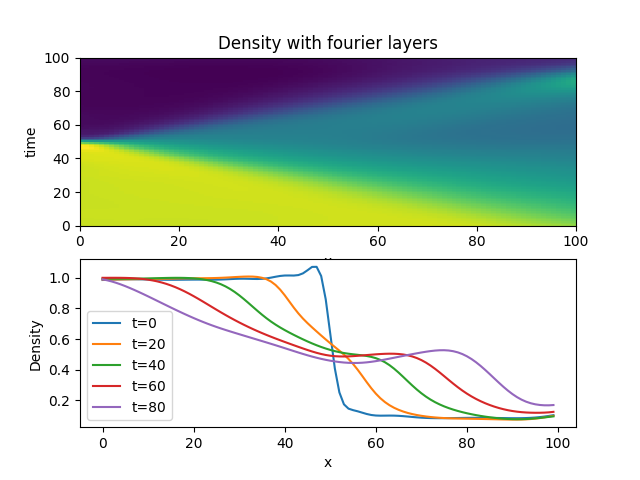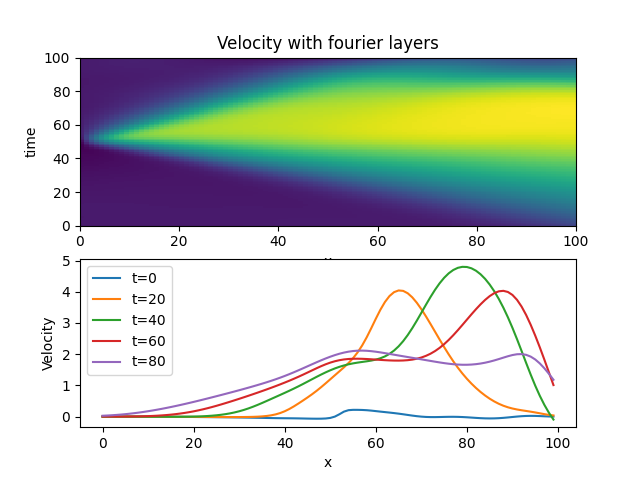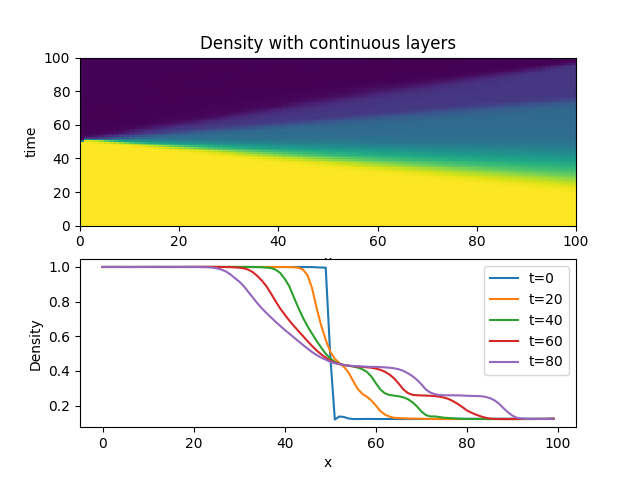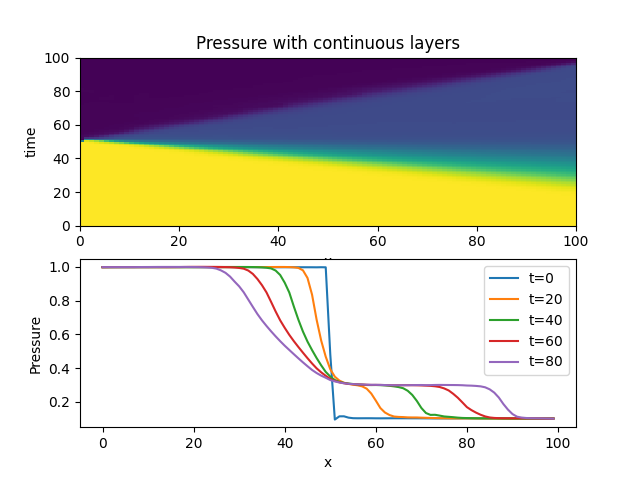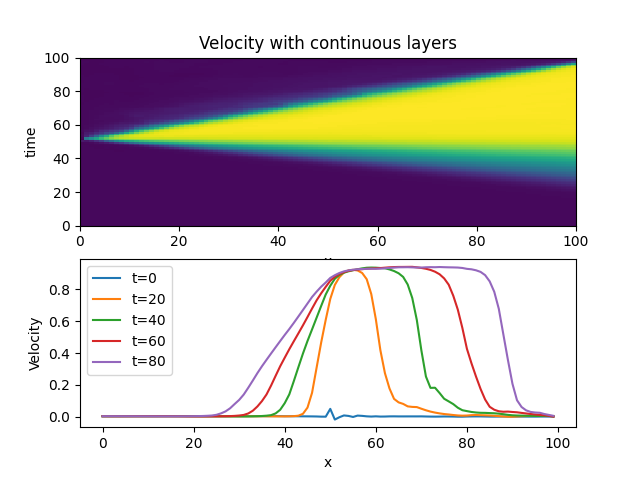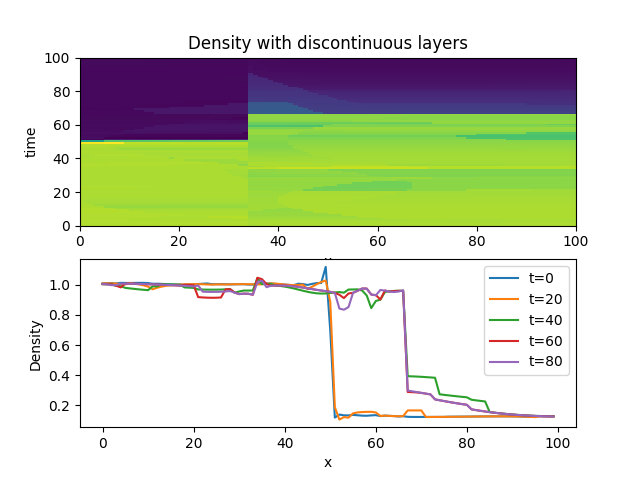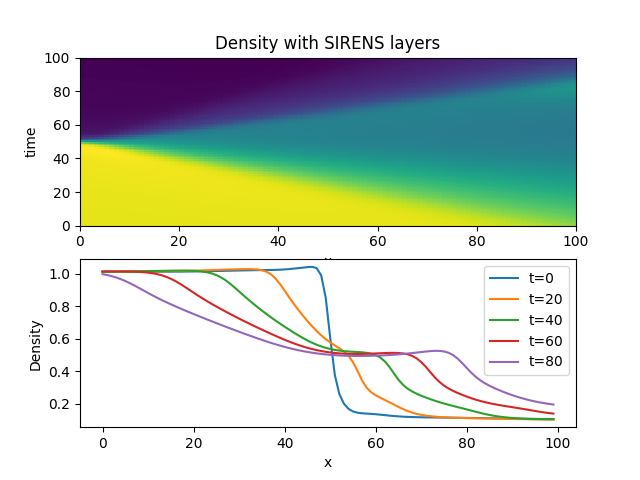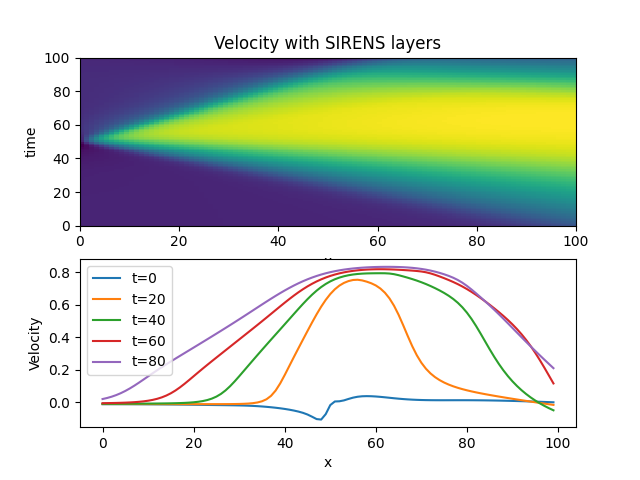Neural Network Implicit Representation of Partial Differential Equations. The problems here are solved using a simple high order MLP where the the input is (x,t) in 1D and the output is density, velocity and pressure. The loss function is partial differential equation for the 1d euler equations of gas dynamics dotted with itself. The resulting model contains the entire solution at every time point and every space point between start and end.
where r=0. The PDE is used as the loss function and r is the residual so that
"Solutions" to the Sod Shock problem in fluid dynamics, which is 1 dimensional ideal compressible gas dynamics (euler equations), a very classic problem. Solutions need to be much better (and faster) before I try and extend to much more complicated systems. I'll try and improve on this as I have time.
The solution at t=0 should be a step function. The model need to learn the initial conditions as well as all the boundary conditions and the interior solution. You can see here the initial condition is not perfect.
This is actually the 5th order polynomial (not 6th) using 12 layers and mesh refinement. Shocks aren't sharp enough to call it good.
python examples/high_order_euler.py mlp.hidden.width=20 max_epochs=10000 mlp.segments=2 mlp.n=2 mlp.hidden.layers=12 factor=0.025 mlp.layer_type=continuous optimizer.patience=200000 mlp.input.segments=10 batch_size=2048 form=primitive loss_weight.discontinuity=0.0 loss_weight.interior=1.0 optimizer=adam mlp.normalize=maxabs mlp.rotations=4 gradient_clip=0.0 loss_weight.boundary=10 loss_weight.initial=10 data_size=10000 mlp.resnet=False refinement.type=p_refine refinement.epochs=500 refinement.target_n=6 refinement.start_n=2
In this case it gets the initial condition almost exactly right and can produce genuine discontinuities, but it's clearly showing many wrong and entropy violating shocks (not to mention not conserving mass etc...). I need to add some penalty function here to prevent bad shocks. This one converged the fastest by far. The wave reflects at the boundary as I'm using dirichlet bcs for now. I believe this is the best long term approach if I can get rid of these various problems.
Following SIRENS style network
SIRENS is just a standard MLP with a sinusoidal positional embedding at the input and sin wave activation functions. In this particular case the model has 8 hidden layers where each hidden layer is 100 units wide.
Using quadratic polynomial creates a sharper shock. Using a large number of input segments (20) and then just 2 for each following layer produces smooth results (no contact discontinuity though!). Primitive form of the equations seems to be working better than conservative form - conservative form pushes to the initial condition even when dropping loss weight at shocks (possible I've introduced another error in my code).
python examples/high_order_euler.py mlp.hidden.width=40 max_epochs=10000 mlp.segments=2 mlp.n=3 mlp.hidden.layers=2 factor=0.1 mlp.layer_type=continuous optimizer.patience=200 mlp.input.segments=20 batch_size=512 form=primitive loss_weight.discontinuity=1.0 loss_weight.interior=0.1 optimizer=adamw
and, adding additional rotations
python examples/high_order_euler.py mlp.hidden.width=40 max_epochs=10000 mlp.segments=2 mlp.n=3 mlp.hidden.layers=2 factor=0.1 mlp.layer_type=discontinuous optimizer.patience=200 mlp.input.segments=20 batch_size=512 form=primitive loss_weight.discontinuity=1.0 loss_weight.interior=0.1 optimizer=adamw mlp.normalize=maxabs mlp.rotations=4
better (starting to see a contact discontinuity - unfortunately it's showing up in pressure as well)
python examples/high_order_euler.py mlp.hidden.width=40 max_epochs=10000 mlp.segments=4 mlp.n=4 mlp.hidden.layers=4 factor=0.025 mlp.layer_type=continuous optimizer.patience=200 mlp.input.segments=20 batch_size=512 form=primitive loss_weight.discontinuity=0.0 loss_weight.interior=1.0 optimizer=adam mlp.normalize=maxabs mlp.rotations=4 gradient_clip=5.0 loss_weight.boundary=10 loss_weight.initial=10 data_size=10000
more better - note that adamw seems to work faster as well as larger batch size batch_size=2048 > 512 > 128. Number of rotations doesn't seem to be a huge issue as long as its > 1.
python examples/high_order_euler.py mlp.hidden.width=20 max_epochs=10000 mlp.segments=2 mlp.n=3 mlp.hidden.layers=3 factor=0.025 mlp.layer_type=continuous optimizer.patience=1000 mlp.input.segments=20 batch_size=2048 form=primitive loss_weight.discontinuity=0.0 loss_weight.interior=1.0e-1 optimizer=adamw mlp.normalize=maxabs mlp.rotations=6 gradient_clip=5.0 loss_weight.boundary=10 loss_weight.initial=10 data_size=10000 mlp.resnet=False
with polynomial refinement
python examples/high_order_euler.py mlp.hidden.width=20 max_epochs=10000 mlp.segments=4 mlp.n=3 mlp.hidden.layers=8 factor=0.025 mlp.layer_type=continuous optimizer.patience=200 mlp.input.segments=20 batch_size=2048 form=primitive loss_weight.discontinuity=0.0 loss_weight.interior=1.0e-1 optimizer=adamw mlp.normalize=maxabs mlp.rotations=6 gradient_clip=5.0 loss_weight.boundary=10 loss_weight.initial=10 data_size=10000 mlp.resnet=False refinement.type=p_refine refinement.epochs=1000
this one actually got the contact discontinuity, but the velocity is wrong
python examples/high_order_euler.py mlp.hidden.width=10 max_epochs=10000 mlp.segments=2 mlp.n=3 mlp.hidden.layers=8 factor=0.025 mlp.layer_type=continuous optimizer.patience=200 mlp.input.segments=20 batch_size=2048 form=primitive loss_weight.discontinuity=0.0 loss_weight.interior=1.0e-1 optimizer=adamw mlp.normalize=maxabs mlp.rotations=4 gradient_clip=5.0e-1 loss_weight.boundary=10 loss_weight.initial=10 data_size=10000 mlp.resnet=False refinement.type=p_refine refinement.epochs=1000
another with contact discontinuity and correct velocity, 8 layers and 10th order polynomial using refinement for subsequent initialization of each model.
python examples/high_order_euler.py mlp.hidden.width=20 max_epochs=10000 mlp.segments=2 mlp.n=2 mlp.hidden.layers=8 factor=0.025 mlp.layer_type=continuous optimizer.patience=200 mlp.input.segments=10 batch_size=2048 form=primitive loss_weight.discontinuity=0.0 loss_weight.interior=1.0e-1 optimizer=adamw mlp.normalize=maxabs mlp.rotations=4 gradient_clip=5.0e-1 loss_weight.boundary=10 loss_weight.initial=10 data_size=10000 mlp.resnet=False refinement.type=p_refine refinement.epochs=500 refinement.target_n=11
This one produced a pretty solid rarefaction wave, could be steeper (developed at 6th order) using "waves" approach.
python examples/high_order_euler.py mlp.hidden.width=20 max_epochs=10000 mlp.segments=2 mlp.n=2 mlp.hidden.layers=12 factor=0.025 mlp.layer_type=continuous optimizer.patience=200 mlp.input.segments=10 batch_size=2048 form=primitive loss_weight.discontinuity=0.0 loss_weight.interior=1.0e-1 optimizer=adamw mlp.normalize=maxabs mlp.rotations=4 gradient_clip=5.0e-1 loss_weight.boundary=10 loss_weight.initial=10 data_size=10000 mlp.resnet=False refinement.type=p_refine refinement.epochs=500 refinement.target_n=20 refinement.start_n=2
back to adam, which works fine with refinement at high order and with gradient clipping turned off. May be problematic when doing high order without initializing from a lower order solution. In this all the shock structure is there, shocks are just too smoothed out.
python examples/high_order_euler.py mlp.hidden.width=20 max_epochs=10000 mlp.segments=2 mlp.n=2 mlp.hidden.layers=8 factor=0.025 mlp.layer_type=continuous optimizer.patience=200000 mlp.input.segments=10 batch_size=2048 form=primitive loss_weight.discontinuity=0.0 loss_weight.interior=1.0e-1 optimizer=adam mlp.normalize=maxabs mlp.rotations=4 gradient_clip=0.0 loss_weight.boundary=10 loss_weight.initial=10 data_size=10000 mlp.resnet=False refinement.type=p_refine refinement.epochs=500 refinement.target_n=6 refinement.start_n=2
Nothing to see below, runs but doesn't converge. Probably some different normalization.
python examples/high_order_euler.py mlp.hidden.width=20 max_epochs=10000 mlp.segments=2 mlp.n=5 mlp.hidden.layers=1 mlp.layer_type=switch_discontinuous optimizer.patience=200000 mlp.input.segments=10 batch_size=2048 form=primitive loss_weight.discontinuity=0.0 loss_weight.interior=1.0e-1 optimizer=adam mlp.normalize=maxabs mlp.rotations=4 gradient_clip=0.0 loss_weight.boundary=10 loss_weight.initial=10 data_size=10000 mlp.resnet=True
High order MLP
python examples/high_order_euler.py
Standard MLP following SIRENS with sin waves and sin wave positional embedding.
python examples/sirens_euler.py
python examples/high_order_euler.py checkpoint=\"outputs/2021-04-25/18-54-45/lightning_logs/version_0/checkpoints/'epoch=0.ckpt'\" train=False
pytest tests
Papers for me to read solving similar problems
Discontinuity Computing using Physics Informed Neural Networks
ACTIVE LEARNING BASED SAMPLING FOR HIGH-DIMENSIONAL NONLINEAR PARTIAL DIFFERENTIAL EQUATIONS

